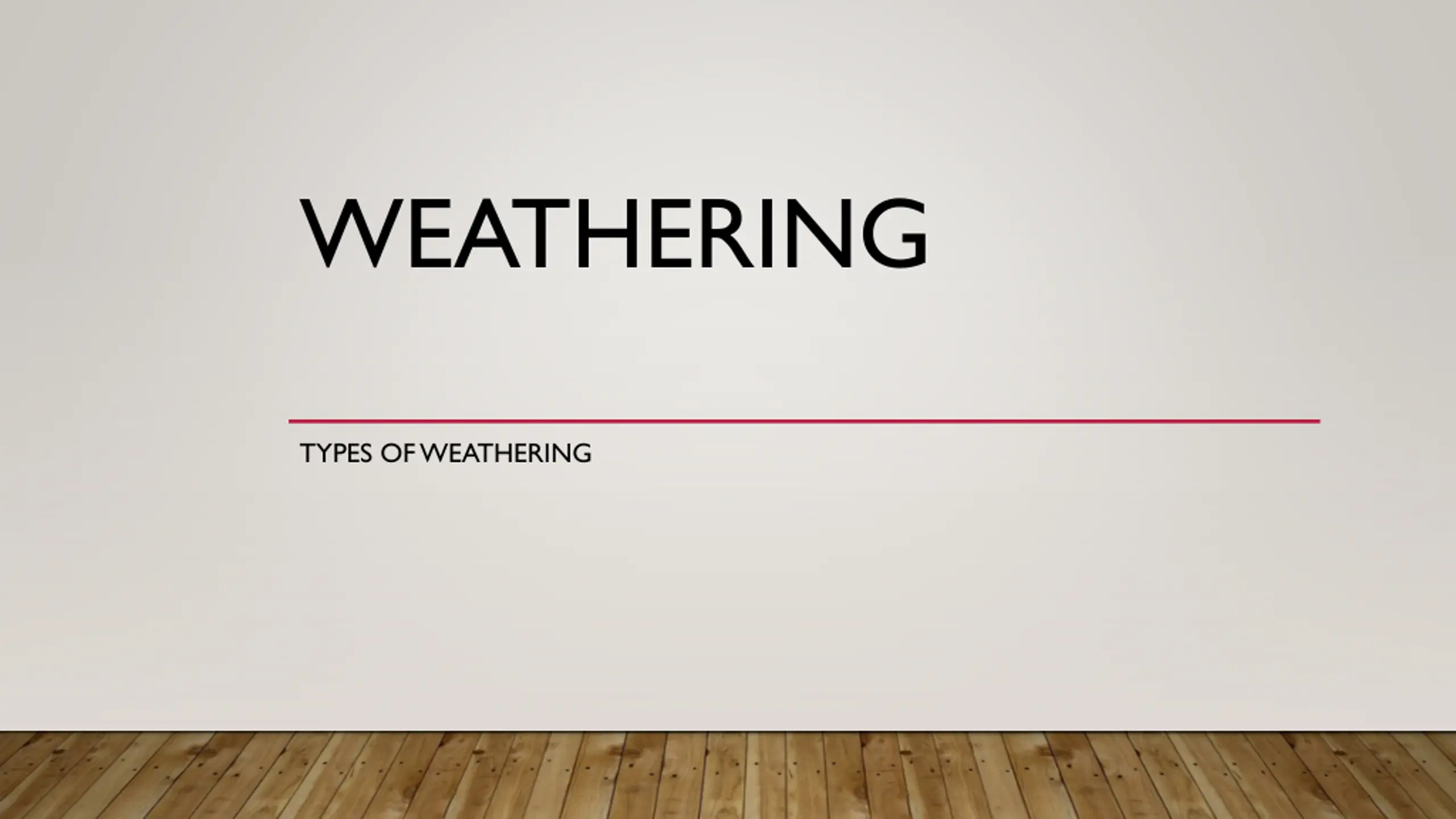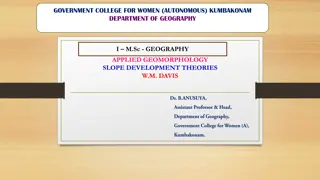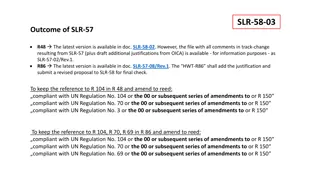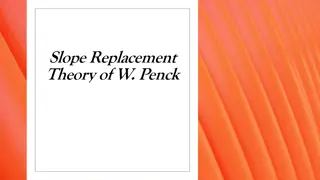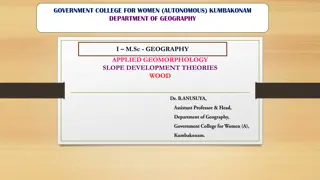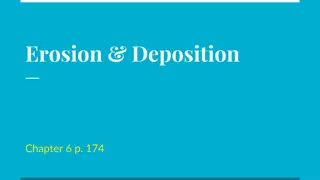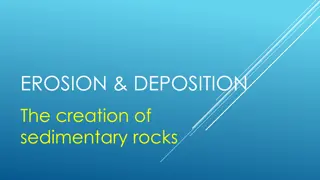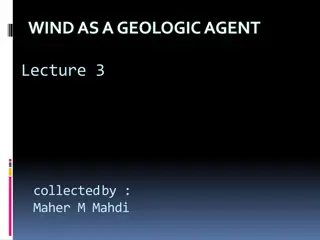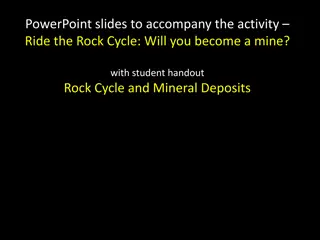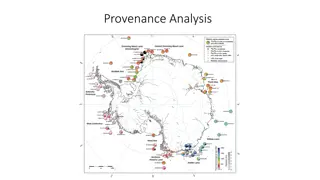Weathering: Types of Weathering
Discover the process of weathering as sun, rain, frost, and wind break down rocks over time. Learn about factors such as rock properties, climate, soil, and exposure length that influence the rate of weathering. Gain insights into different types of weathering and how they shape the Earth's surface.
Download Presentation

Please find below an Image/Link to download the presentation.
The content on the website is provided AS IS for your information and personal use only. It may not be sold, licensed, or shared on other websites without obtaining consent from the author.If you encounter any issues during the download, it is possible that the publisher has removed the file from their server.
You are allowed to download the files provided on this website for personal or commercial use, subject to the condition that they are used lawfully. All files are the property of their respective owners.
The content on the website is provided AS IS for your information and personal use only. It may not be sold, licensed, or shared on other websites without obtaining consent from the author.
E N D
Presentation Transcript
WEATHERING TYPES OF WEATHERING
What is Weathering? The scenes of the world are continuously mutating. Sun, rain, frost, and wind are breaking down even the most solid of the rocks into smaller bits before they are taken away. This process is termed as weathering. The action of the elements of climate and weather, animals, and plants on the land surfaces to break them down biologically, chemically, and physically is called weathering. It is the breakdown and decay of rocks in situ. It can be a very elongated slow procedure, taking hundreds of years. However, weathering can also be rapid, such as the damage to pavements or roads after a cold, frosty winter.
Factors Which Control the Rates of Weathering Properties of the Parent Rock 1. The mineralogy and structure of a rock affects it s susceptibility to weathering. 2. Different minerals weather at different rates. Mafic silicates like olivine and pyroxene tend to weather much faster than felsic minerals like quartz and feldspar. Different minerals show different degrees of solubility in water in that some minerals dissolve much more readily than others. Water dissolves calcite more readily than it does feldspar, so calcite is considered to be more soluble than feldspar. 3. A rock s structure also affects its susceptibility to weathering. Massive rocks like granite generally to not contain planes of weakness whereas layered sedimentary rocks have bedding planes that can be easily pulled apart and infiltrated by water. Weathering therefore occurs more slowly in granite than in layered sedimentary rocks.
Climate 1. Rainfall and temperature can affect the rate in which rocks weather. High temperatures and greater rainfall increase the rate of chemical weathering. 2. Rocks in tropical regions exposed to abundant rainfall and hot temperatures weather much faster than similar rocks residing in cold, dry regions. Soil 1. Soils affect the rate in which a rock weathers. Soils retain rainwater so that rocks covered by soil are subjected to chemical reactions with water much longer than rocks not covered by soil. Soils are also host to a variety of vegetation, bacteria and organisms that produce an acidic environment which also promotes chemical weathering. 2. Minerals in a rock buried in soil will therefore break down more rapidly than minerals in a rock that is exposed to air.
Length of Exposure The longer a rock is exposed to the agents of weathering, the greater the degree of alteration, dissolution and physical breakup. Lava flows that are quickly buried by subsequent lava flows are less likely to be weathered than a flow which remains exposed to the elements for long periods of time.
Types of Weathering Weathering is the initial step in soil creation. Weathering happens in three different manners: These include chemical weathering, physical weathering, biological weathering. The three major ways weathering happens include chemical, physical, and mechanical weathering which are explained below. How is Weathering different from Erosion? Weathering has no moving agent of transport, whereas in Erosion the rock and upper layer soil particles are worn away and moved elsewhere by water, wind, etc.
Physical weathering- IT happens when rocks are fragmented into minor fragments while ensuring no alterations in their chemical makeup. The main causes behind physical weathering include spontaneous fluctuations in temperature like too high or too low heat or cold. Variations temp. would be the causal element of freeze-thaw action and this occurs when water gets collected in the fissures in rocks all through the day and during the temperature drops at night that would be sufficient to freeze water into ice. It is a known fact that almost every substance grows in size when heated and contracts when exposed to low-temperature situations. Unlike these cases, water converts to ice when the temperature goes below zero and actually expands. The resultant action would result in the expansion of the fissures and during day time water melts ,continuous freezing and melting leads to breaking of rocks.
Chemical Weathering Chemical weathering happens when the chemicals get diluted and dissolved in water and seep and percolate down the rock surfaces. Chemical weathering happens in areas having high temperatures and enough supply of water alike tropical environments that are humid. While the chemical weathering happens, the composition of minerals alters due to the reaction of chemicals in water or air. This also results in the rock decomposition The water ultimately may carry these materials to rivers and then to the sea. This is the source of the salinity of the oceans. The instances of chemical weathering are oxidation, the decay of calcium carbonate, etc.
BENEFITS OF WEATHERING Formation of Nutrient-Rich Soil The very process of weathering creates the soil, which then allows life to flourish on Earth. 1.Creation of Sediments When broken, some rock pieces and particles eventually turn into sediments that are formed into different types of sedimentary rocks like sandstones and limestones. 2.Contribution To Land Formation
